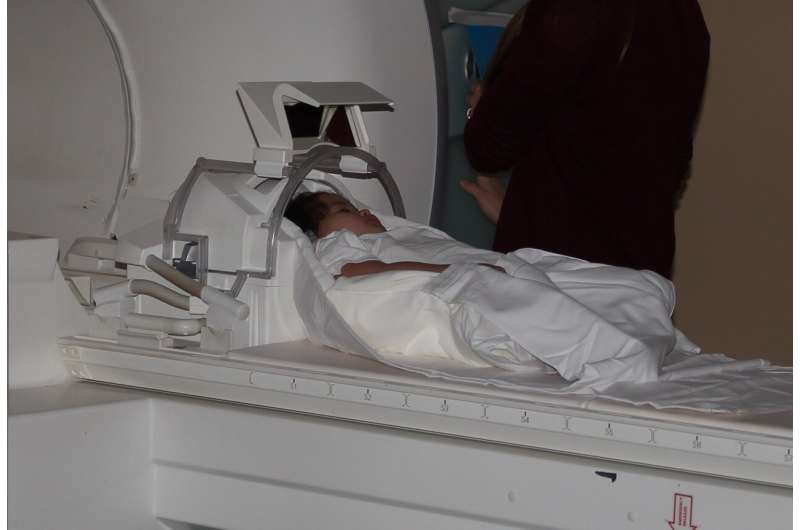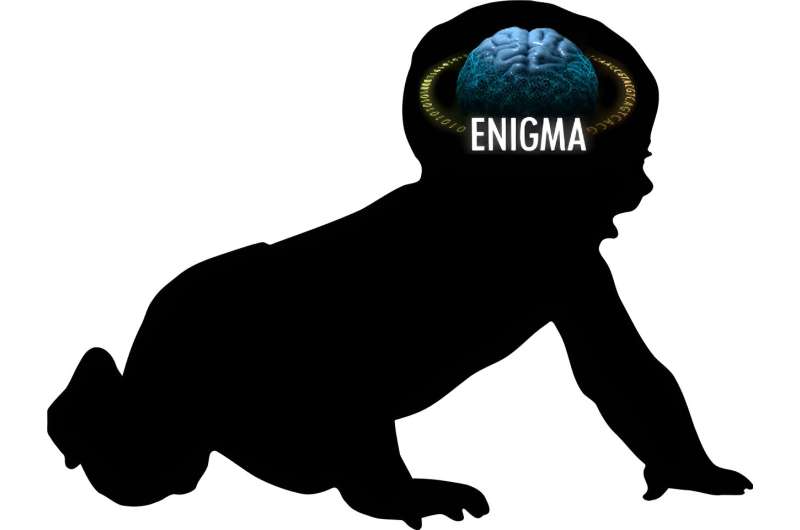December 14, 2023 feature
This article has been reviewed according to Science X's editorial process and policies. Editors have highlighted the following attributes while ensuring the content's credibility:
fact-checked
peer-reviewed publication
trusted source
proofread
Global research collaboration maps brain development in infancy and early childhood

The brains of infants and young children are in continuous and rapid development. These changes are known to go hand in hand with early life learning and the fine-tuning of mental abilities over time.
The ENIGMA ORIGINs consortium, a research collaboration based at different institutes worldwide, was established in 2017 to enable large-scale collaborative studies rooted in neuroscience and genetics. In a recent paper, published in Nature Neuroscience, researchers involved in this collaboration presented a detailed map of the development of subcortical brain regions in infancy and early childhood.
"This is first empirical paper arising from the ENIGMA-ORIGINs consortium," Rebecca C. Knickmeyer, co-author of the paper, told Medical Xpress. "The consortium was established with the aim of exploring the influence of genetic and environmental factors on brain morphometry, anatomical and functional connectivity, and cognitive and emotional function from birth to age 6. This specific paper was inspired by prior studies demonstrating that brain development in this period is highly dynamic and may have long-term consequences for mental health."
The primary objective of the recent study by Knickmeyer and her colleagues was to map the development and volume of intracranial and subcortical brain regions from birth to the age of 6, collecting data in different regions worldwide. By examining the brains of infants and children born in different places, the team hoped to better understand the impact of sociodemographic factors and adverse birth outcomes on brain development. In addition, their study was aimed at exploring the complex relationship between individual differences in intracranial and subcortical volumes and cognition.
"We used magnetic resonance imaging (MRI) scans to generate intracranial volume (ICV) and the volume of specific subcortical structures, including the thalamus, hippocampus, amygdala, caudate, putamen and globus pallidus," Knickmeyer said. "We analyzed a total of 3,607 individual scans collected from 2,108 infants and young children from eight different cohorts around the world."
The ENIGMA-ORIGINs consortium collected data in four countries, including the United States, Germany, Singapore, and South Africa. The researchers analyzed the wide pool of data they collected using statistical models that allowed them to observe the progression of subcortical volumes over time, while also relating these volumes to various factors, including sex, birthweight, prematurity, maternal education, family income, and the results of children in cognitive tests.

Overall, the results of these statistical analyses confirm that intracranial and subcortical volumes grow extremely quickly in infancy and early childhood. In addition, they highlight the vulnerability of the early brain to adverse environmental factors, such as poverty and preterm birth.
"We also saw that the effects of sociodemographic factors on cognitive scores are partially mediated by brain volumes," Knickmeyer explained. "From a practical point of view, we think that rapid brain growth in infancy and early childhood may make this an especially promising period for interventions designed to promote healthy brain growth and minimize/eliminate environmental insults."
This first paper by the ENIGMA-ORIGINs consortium confirms the effects of early circumstances and experiences on the development of the brain in infancy and early childhood. Most notably, it emphasizes the importance of minimizing pre-term births and addressing existing socioeconomic disparities, to facilitate the healthy development of children.
"In particular, efforts to provide material and social support to pregnant women and mothers of infants and young children could support brain development in their children and reduce later achievement gaps," Knickmeyer said.
The ENIGMA-ORIGINs consortium is now planning further international research efforts. Their goal is to ultimately compile the largest-ever imaging and genomics dataset specifically focusing on infancy and early childhood. In the future, this dataset could be analyzed by other research teams worldwide, potentially leading to new important discoveries.
Knickmeyer added, "We plan to use this dataset to study how genes linked to neurodevelopmental conditions like autism and ADHD and genes linked to psychiatric conditions like schizophrenia influence brain development and behavior in early life, and to determine how common genetic variants influence the development of brain structure and connectivity.
"We also plan to study the development of other neuroimaging phenotypes and their relationships with sex, birthweight, prematurity, maternal education, family income, and cognition. This will include studies of major axonal pathways in the brain (i.e., the brain's telephone wires) using something called diffusion tensor imaging and studies of the brain's functional organization using functional MRI."
More information: Ann M. Alex et al, A global multicohort study to map subcortical brain development and cognition in infancy and early childhood, Nature Neuroscience (2023). DOI: 10.1038/s41593-023-01501-6
© 2023 Science X Network



















